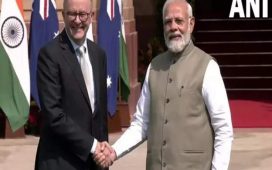As the UK prepares for a general election this year, voters will be entering an electoral landscape in which the rules of the game have changed.
The Conservative government has raised thresholds for party spending, required voters to have a photo ID to cast their ballots and presided over the biggest shake-up of constituency boundaries in two decades.
Some opposition figures are adamant that, taken together, the changes could boost the Conservatives’ electoral prospects.
Current polls suggest that 44 per cent of Britons intend to vote Labour, 25 per cent for the Tories and 10 per cent each for the Liberal Democrats and Reform.
Others believe the effect of the changes are too hard to predict, particularly as voters have become much less loyal to specific parties.
Meanwhile, new artificial intelligence tools and the emergence of more opinionated right-wing broadcast channels could add volatility to the election as voters weigh up their options.
What is undeniable, according to John McTernan, Tony Blair’s former political strategist, is that “almost everything is different this time around”.
Spending limits and donations
This year, parties are set to raise and spend more than ever before after the government in 2023 uprated party and candidate spending limits to reflect the impact of inflation. The limits had not been changed since 2000.
The result is an 80 per cent increase in party spending limits, from £19.5mn to £35mn. The amount people can donate without declaring their identity has also increased from £7,500 to £11,180.
The Conservatives have historically succeeded in raising more than other British parties, including £19.4mn at the last general election in 2019, two-thirds of all party donations.
They also typically outspend more than the other parties, including nearly £17mn at the last election in 2019. At that poll the Liberal Democrats uncharacteristically outspent the much bigger Labour party after receiving an £8mn donation.
More recently, the Tories raised three times as much as Labour in the three months to September with a £15.8mn haul.
Dave McCobb, director of field campaigns for the Lib Dems, said it was “blindingly obvious” that the threshold changes would “benefit the party that institutionally has the most money”.
David Davis, a senior Conservative MP and former minister, countered that the increased spending thresholds would have little impact as “90 per cent of electoral spending is wasted anyway”.
Boundary changes and voter ID
The UK’s first-past-the-post electoral system means it matters a lot where seats are situated and how many people are in them. Political parties win based on the number of constituencies they secure, rather than their overall share of the vote.
The shake-up of boundaries at the election this year will affect 90 per cent of constituencies, resulting in England gaining 10 new seats, Scotland losing two and Wales losing eight.
If these boundary changes had been in place at the 2019 general election, the Conservatives would have won six more seats, with Labour, the Lib Dems and the SNP each getting two fewer, according to a Financial Times analysis.
The Conservatives also introduced the requirement to show identification in general and local elections from 2023, meaning that for the first time every voter must bring valid photo ID in order to cast a ballot.
The rules permit a broader range of valid IDs for older people, who are more likely to vote Tory, than for younger voters. Travel cards for older people are allowed, but young person travel cards are not.
London Mayor Sadiq Khan, who is expected to be re-elected in May, has warned that young people and voters from ethnic minority backgrounds, who typically lean towards Labour, could be particularly affected by the change.
Voter ID was trialled in the May 2022 local elections and a preliminary analysis of the impact by the Electoral Commission found that about 14,000 people were unable to vote. This was about 0.25 per cent of voters, but the impact was greater for lower income voters, the regulator found.
The impact could be larger this year as voters in a general election may be less inclined to return to a polling station with identification if they are initially turned away.
Davis said the requirement could prejudice a generation of older working class people who have never had photo ID and said “if Labour win, they should abolish the whole requirement”.
He argued however that most of the changes introduced by his party would have an unknown and “unpredictable” impact, adding that accusations the Tories were plotting to tilt the election was a “conspiracy theory”.
A government spokesperson said: “The changes we have made to UK elections ensure that they remain secure, fair, modern, inclusive and transparent. We are placing British citizens’ participation at the heart of our democracy and ensuring that their confidence in UK elections is maintained.”
A shifting media backdrop
The next UK general election will be the first since the rise of powerful new AI tools such as OpenAI’s ChatGPT.
At the same time the platform X, still central to UK political discourse, has slashed resources for moderation as part of Elon Musk’s stated mission to restore free speech absolutism.
Online disinformation has been a factor in elections for many years but recent, rapid advances in AI mean it is cheaper and easier than ever to produce doctored content.
Britain has seen a smattering of examples of fake content depicting prominent politicians in the past year, including false audio of UK opposition leader Sir Keir Starmer berating assistants.
Robert Hayward, a Conservative peer and polling expert, said the “nature and scale of the threat is much greater than ever before”.
“It’s not suddenly going to take off at one general election but it will be a rising continuum,” he said.

It comes at a time when the electorate’s commitment to specific political parties is at an ebb. Research from Oxford university suggests the proportion of British voters that switch their party allegiances has shifted from about 13 per cent in 1960 to closer to 60 per cent today.
Against this backdrop, two new right-wing broadcast media outlets — GB News and TalkTV — have emerged since the 2019 election.
Though still small compared with more mainstream channels, the platforms have tested the UK’s rules on broadcast media impartiality.
GB News, the bigger of the two, is seen by many as Britain’s answer to America’s Fox News and reaches about 600,000 people a day, compared with 2.4mn for BBC News and 1.7mn for Sky News, according to Enders Analysis. Only 10 per cent of the GB News audience account for three-quarters of all hours viewed.
Some in the Labour party think the channels could work to their benefit by forcing the Tories to adopt more extreme positions or risk losing core voters to the Reform UK party, which is threatening the Conservative’s right flank.












